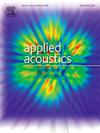Improving the accuracy of vibration reduction index measurements: Assessing and correcting parasitic airborne noise effects
IF 3.4
2区 物理与天体物理
Q1 ACOUSTICS
引用次数: 0
Abstract
The vibration reduction index Kij, measured in accordance with ISO 10848, is used to assess the attenuation of vibration transmissions at junctions between structural elements. In particular, it is used to compare the performance of different junctions or as input data for predictive calculations in the ISO 12354 standards series.
However, this measurement can be affected by parasitic airborne noise generated by the excitation source and acoustic radiation from the excited wall, leading to an underestimation of Kij, particularly for high-performance junctions such as those incorporating resilient strips.
This article presents the results of numerical simulations based on the finite element method and experimental measurements carried out on two CLT mock-ups in two laboratories, one in Italy and the other in Belgium. These analyses highlight the influence of parasitic airborne noise on Kij measurements and underline the importance of minimising it as much as possible during testing to ensure the reliability of the values obtained. If this is not possible, a correction based on the subtraction of the contribution of unwanted airborne noise can be applied to improve the accuracy of the results.
The conclusions of this study are generalizable to any type of construction element and also to in situ measurements. The issue of incorporating parasitic airborne transmission into the predictive calculations of ISO 12354 standards is therefore raised, particularly when the construction elements of junctions incorporating a resilient strip are not combined with a lining or floating screed.
提高减振指数测量的准确性:评估和纠正寄生空气噪声效应
根据ISO 10848测量的减振指数Kij用于评估结构元件之间连接处振动传输的衰减。特别是,它用于比较不同结点的性能,或作为ISO 12354标准系列中预测计算的输入数据。然而,这种测量可能会受到激发源产生的寄生空气噪声和来自激励壁的声辐射的影响,导致Kij的低估,特别是对于那些包含弹性条的高性能结。本文介绍了基于有限元方法的数值模拟结果和在意大利和比利时两个实验室的两个CLT模型上进行的实验测量。这些分析强调了寄生空气噪声对Kij测量的影响,并强调了在测试过程中尽可能减少空气噪声的重要性,以确保所获得值的可靠性。如果这是不可能的,基于减去不必要的空气噪声贡献的修正可以应用于提高结果的准确性。本研究的结论可推广到任何类型的建筑单元,也适用于现场测量。因此,将寄生空气传播纳入ISO 12354标准的预测计算的问题被提出,特别是当结合弹性带的结的构造元素没有与衬里或浮动找平板结合时。
本文章由计算机程序翻译,如有差异,请以英文原文为准。
求助全文
约1分钟内获得全文
求助全文
来源期刊

Applied Acoustics
物理-声学
CiteScore
7.40
自引率
11.80%
发文量
618
审稿时长
7.5 months
期刊介绍:
Since its launch in 1968, Applied Acoustics has been publishing high quality research papers providing state-of-the-art coverage of research findings for engineers and scientists involved in applications of acoustics in the widest sense.
Applied Acoustics looks not only at recent developments in the understanding of acoustics but also at ways of exploiting that understanding. The Journal aims to encourage the exchange of practical experience through publication and in so doing creates a fund of technological information that can be used for solving related problems. The presentation of information in graphical or tabular form is especially encouraged. If a report of a mathematical development is a necessary part of a paper it is important to ensure that it is there only as an integral part of a practical solution to a problem and is supported by data. Applied Acoustics encourages the exchange of practical experience in the following ways: • Complete Papers • Short Technical Notes • Review Articles; and thereby provides a wealth of technological information that can be used to solve related problems.
Manuscripts that address all fields of applications of acoustics ranging from medicine and NDT to the environment and buildings are welcome.
 求助内容:
求助内容: 应助结果提醒方式:
应助结果提醒方式:


